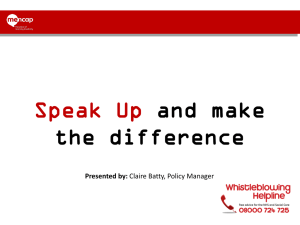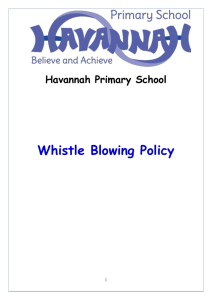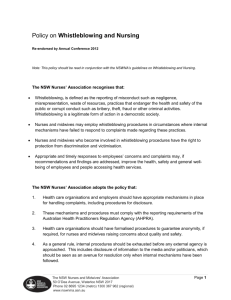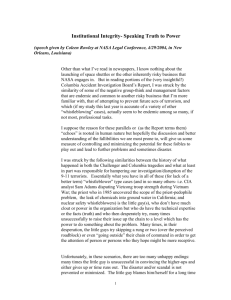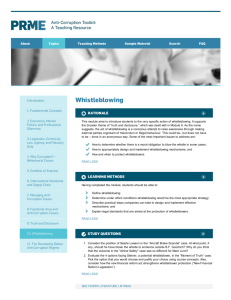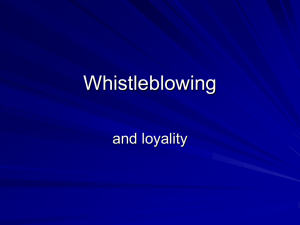The Duty of Loyalty Versus the Duty to Inform
advertisement
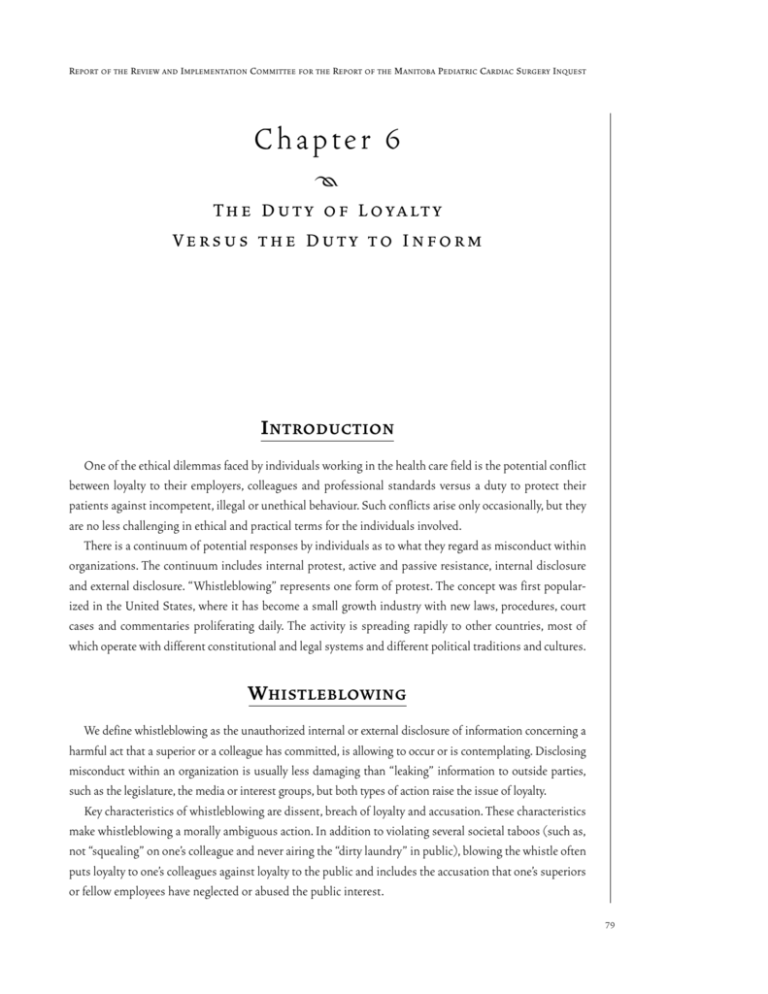
REPORT OF THE REVIEW AND IMPLEMENTATION COMMITTEE FOR THE REPORT OF THE MANITOBA PEDIATRIC CARDIAC SURGERY INQUEST Chapter 6 a Th e D u t y o f L o y a lt y Versus the Duty to Inform I NTRODUCTION One of the ethical dilemmas faced by individuals working in the health care field is the potential conflict between loyalty to their employers, colleagues and professional standards versus a duty to protect their patients against incompetent, illegal or unethical behaviour. Such conflicts arise only occasionally, but they are no less challenging in ethical and practical terms for the individuals involved. There is a continuum of potential responses by individuals as to what they regard as misconduct within organizations. The continuum includes internal protest, active and passive resistance, internal disclosure and external disclosure. “Whistleblowing” represents one form of protest. The concept was first popularized in the United States, where it has become a small growth industry with new laws, procedures, court cases and commentaries proliferating daily. The activity is spreading rapidly to other countries, most of which operate with different constitutional and legal systems and different political traditions and cultures. W HISTLEBLOWING We define whistleblowing as the unauthorized internal or external disclosure of information concerning a harmful act that a superior or a colleague has committed, is allowing to occur or is contemplating. Disclosing misconduct within an organization is usually less damaging than “leaking” information to outside parties, such as the legislature, the media or interest groups, but both types of action raise the issue of loyalty. Key characteristics of whistleblowing are dissent, breach of loyalty and accusation. These characteristics make whistleblowing a morally ambiguous action. In addition to violating several societal taboos (such as, not “squealing” on one’s colleague and never airing the “dirty laundry” in public), blowing the whistle often puts loyalty to one’s colleagues against loyalty to the public and includes the accusation that one’s superiors or fellow employees have neglected or abused the public interest. 79 C H A P T E R 6 ■ THE DUTY OF LOYALTY VERSUS THE DUTY TO INFORM On the other hand, such actions of individual dissent are seen as an important way to ensure that large bureaucracies are operating in a legal, effective, efficient, responsive, ethical and accountable manner. Studies suggest that whistleblowers pay a high price in terms of their careers and their personal lives. This leads to calls for stronger legal protections for individuals who legitimately and reasonably disclose wrongdoing, and for greater accountability for their organizations and their leaders who retaliate against justified dissent. If these are the benefits of whistleblowing in the public sector, there are also costs. Regardless of how whistleblowing complaints are resolved, there is bound to be some damage to the image and reputation of a government as a whole. There are also costs to the particular public organizations involved, such as the expense and staff time to deal with accusations and the divisions within the organization which may impair its productivity. Costs to government will ultimately end up being costs to taxpayers. Ideally, organizations should adopt strategies and activities to reduce the need for employees to resort to whistleblowing. A strategy of prevention would include such elements as: improved communication; an interpersonal climate which fosters mutual respect and support; a culture which tolerates dissent and promotes teamwork, learning and continuous improvement; the use of forums and procedures to channel conflict and disagreements in positive directions; and the adoption of codes of conduct. Even with such measures, there may still be a perceived need for formal protection of whistleblowers against retaliation when they raise matters that eventually prove to be substantively justified. Whistleblowing should be considered only after all other avenues of addressing a problem have been tried. Ideally, the rules and procedures respecting whistleblowing should encourage “good” types of whistleblowing and discourage “bad” types of such activity. Unfortunately, what constitutes positive versus harmful whistleblowing often involves facts in contention and value-laden subjective judgements. In short, owing to the complexity of the activity, whistleblowing is not an activity that lends itself to immutable rules. Not all situations of perceived risk to the public interest justify whistleblowing and not all whistleblowers are driven by purely altruistic motives. C ULTURE OF S ILENCE Turning to the events in the pediatric cardiac surgery program at the HSC,the Sinclair Report observes that: • the nurses involved made proper and appropriate use of existing channels to voice their concerns, but were not taken seriously (p. 478); • their concerns were dismissed as stemming from their inability to deal emotionally with the infant deaths (p. 477); • concerns about medical matters were rejected as not having a proper basis; and • nurses were never treated as full and equal partners of the surgical team, reflecting their historical subordinate position in the HSC structure (p. 477). For these reasons, Judge Sinclair concluded that “... the attempted silencing of members of the nursing profession, and the failure to accept the legitimacy of their concerns, meant that serious problems in the pediatric cardiac surgery program were not recognized and addressed in a timely manner.” (p. 478) 80 REPORT OF THE REVIEW AND IMPLEMENTATION COMMITTEE FOR THE REPORT OF THE MANITOBA PEDIATRIC CARDIAC SURGERY INQUEST The problems that arose in the pediatric cardiac surgery at HSC in 1994 seem to be a clear case where some type of whistleblowing protection would have helped the nurses involved to resolve the ethical dilemmas involved with protecting and advocating on behalf of their patients, respecting the values and standards of their profession, maintaining their loyalty to the surgical team and the institution, and avoiding the risks to their own careers and lives. Perhaps no profession faces the complex issues of whistleblowing more directly and dramatically than nurses. This is true for several reasons. They have expertise from education and experience to understand the nature of procedures and why they are undertaken in the delivery of medical care. In hospitals, nurses increasingly work as equal members on the health care team. That same team includes one of the highest status professions – physicians and surgeons. Within the culture of facilities such as the HSC, nurses are perceived as subordinates to physicians and frequently treated in that manner by the medical community. Nurses are employed by the facility and report to managers who for the most part are nurses with advanced education and experience in nursing management. Nurses are accountable to their respective manager, their patients and their professional association for their practice. While nurses are expected to demonstrate respect and loyalty, they are not expected to obey physicians automatically and unquestioningly. Achieving the acceptance of the nurse as a full and respected member of a professional team will require changes to the attitudes of some individual physicians and surgeons, as well as a transformation of the climate and culture of particular medical programs and the institutions in which they are employed. It is recognized that such changes take time, often years, given how deeply entrenched certain attitudes and values have become. We have more to say on the importance of communication, climate, culture and teamwork in other parts of this Report. Within hospitals, nurses have the most continuous contact with patients and owe a strong duty, both professionally and personally, to protect the patient’s welfare. Codes of ethics have been developed for nurses to help them cope with ethical dilemmas when they arise. Codes deal with such values as the promotion of the health and well being of patients, their right to safe, competent and ethical care, confidentiality and accountability – all considerations relevant to nurses deciding whether to blow the whistle. Codes also encourage nurses to support one another when concerns about incompetent, unethical and unsafe care are raised. In the case of the HSC events, the Sinclair Report notes with regret that frustration, fear and a sense of futility led “some nurses to silence themselves” (p. 478). Studies of whistle blowing in other contexts indicate that, more than fear of reprisal, a sense of futility that corrective actions will not be taken is the main reason that people do not speak out when they identify misconduct. In response to the findings about the role of nurses within the HSC in 1994, the Sinclair Report calls for changes to improve the status and involvement of nurses in institutional decision-making, including the promotion of a culture of teamwork and the development of skills in conflict management. We discuss these reforms later in this Report. These reforms are clearly intended to prevent the need for whistleblowing, especially the release of unauthorized information to outside bodies. The Sinclair Report (pp. 478–79) still sees the need to provide protection for prospective whistleblowers on two levels. First, within the employing institution of the HSC, the Report recommends that there should be established a clear policy on how employees are to report concerns about risks to patients. Such a policy would clarify to whom each employee is to report; presumably that would be their supervisor or manager in the 81 C H A P T E R 6 ■ THE DUTY OF LOYALTY VERSUS THE DUTY TO INFORM first instance. The policy should also make clear that there will be no risk of reprisals for the person raising legitimate and reasonably held concerns. As part of the same group of recommendations, the Report also recommended a strengthened Nursing Council within HSC to serve as “a vehicle through which nurses could report incidents, issues and concerns without risk of professional reprisals” (p. 479). The above set of recommendations calls for whistleblowing rules and procedures created by individual institutions in the health care field. However, the Sinclair Report also recommends that the Government of Manitoba consider passing whistleblowing legislation of more general application to “protect nurses and other professionals from reprisal resulting from the disclosure of “legitimately and reasonably held concerns” about “the medical treatment of patients” (p. 479). Like other recommendations in the Sinclair Report, those dealing with disclosure of misconduct may have been overtaken by developments which have occurred since the conclusion of the Inquest. Also, the recommendations are formulated in general terms and any implementation plan would require more detailed, operational issues to be addressed. In terms of subsequent developments at the HSC, a new Nursing Practice Council was established in January, 2001. It has been described by HSC authorities as “a work in progress” in the sense that its mandate, scope of operation, decision-making authority and influence, and its potential as a forum for reviewing and resolving the concerns of nurses related to patient care, are not entirely clear at this point. A VicePresident of Nursing has also been established as another way, to bring nurses’ concerns to the centre of the HSC decision-making process. Voluntary courses on teamwork and conflict management have been offered within the institution. At this point, it is not clear how many physicians and other health professionals will participate in such courses. More is said on these points in other parts of this Report. To date, the HSC Executive and the WRHA Board (to which the HSC President reports) have not developed a formal policy statement on the duty of employees to report risks to patients. Apart from existing reporting relationships and the critical incidents process, there are not identifiable rules and procedures to guide nurses and others in bringing concerns forward within the institution. Apart from common law, employment law and collective agreements, there are not legal protections for prospective whistleblowers who may fear retaliation. I NTERNAL D ISCLOSURE The development of an internal disclosure procedure is preferable to external whistleblowing, both for the organization and the employee. An internal process gives the organization the opportunity to correct the problem and avoid the investigations and negative publicity that usually accompany external whistleblowing. A properly structured and operated internal disclosure procedure also has a better prospect of allowing ethically concerned employees to identify with the organization and continue their careers within it after they have raised their concerns. The provision of internal disclosure mechanisms is also consistent with the statutory provisions and jurisprudence in some jurisdictions. Such whistleblower laws place the onus on the employee to exhaust internal remedies before taking their concerns outside of the organization. 82 REPORT OF THE REVIEW AND IMPLEMENTATION COMMITTEE FOR THE REPORT OF THE MANITOBA PEDIATRIC CARDIAC SURGERY INQUEST While internal disclosure programs have much to recommend them, they may not always be the most appropriate way to encourage employees to come forward with information of serious wrong-doing. Unless an organization has established a “secure channel” which ensures complaints will be dealt with confidentially, employees may be reluctant to report matters to their superiors, even if there is an organizational policy offering protection against reprisal. In addition, the idea that problems can be handled internally, may not be appropriate when serious issues, like alleged illegalities or specific dangers to public health, are involved. Authorities at the HSC and the WRHA have not committed to the development of an internal disclosure policy and procedure. They continue to rely upon existing procedures for reporting concerns–through the chain of command, through the monitoring procedures (critical incident reviews and standards committees), and through the norms of professional behaviour that are reflected in codes of ethics for physicians, nurses and others. P OLIC Y ON I NTERNAL D ISCLOSURE It was not the task of this Committee to develop a detailed policy for how the HSC should deal with employees’ concerns about different kinds of misconduct. However, we believe that such a policy would be of value to the institution and its employees. It could also serve as a model for other institutions throughout the province. Without going into detail, we wish to identify two crucial components of such a policy. The first would be an educational component designed to create a culture and climate which accepts disclosure and discussion of concerns as a valuable source of individual and organizational learning and improvement. It is understandable that health providers in all fields do not like to have their behaviour and judgements challenged. But there needs to be greater recognition that no one, including physicians and nurses, is infallible and that the expression of concerns does not amount to an accusation. To create greater acceptance of the legitimacy of disclosure, a number of steps can be taken. A code of conduct can be adopted. It can cover the types of actions that justify disclosure. It can set forth the procedures to be followed and the protections offered. It should also indicate that unjustified allegations can cause damage to individuals and the institution and that irresponsible or malicious use of the process will have consequences. Such a code should be endorsed at the highest level within the organization – which is usually the board level. Education about the code should be part of the orientation for new staff. Employee groups and unions should be involved in the development and ongoing dialogues about what is proper and improper behaviour. The second component of an internal disclosure policy would deal with the types of behaviour that are reportable, the procedures to be followed and the extent of the protection against reprisal to be provided. Most organizational policies on whistleblowing cover matters like illegal actions, financial malpractice, dangers to health or safety, and cover ups or violations of the code. Employees are first encouraged to follow normal lines of reporting within the organization. However, there is a recognized need to provide another route to raise a concern, such as to the chief executive or another senior officer. Steps are taken to protect the identity of the complainant at least initially. Employees need to be assured that they will be supported 83 C H A P T E R 6 ■ THE DUTY OF LOYALTY VERSUS THE DUTY TO INFORM and protected from reprisals. They need to be informed whether there are external routes if they do not have the confidence to raise a concern internally. There should be a guarantee that the results of an investigation and the actions that follow will be reported back to the complainant. Employees should also be informed that raising unfounded allegations maliciously is potentially a matter for disciplinary action. An internal disclosure policy can serve to galvanize and reinforce existing values of safe, competent, ethical and compassionate care by operating in conjunction with other hospital processes. True responsible behaviour comes about when professional standards and ethical norms are deeply internalized by everyone who works in a hospital. A poorly designed policy and set of procedures could poison the work environment with suspicion, accusations and conflict and could cause stress and damage, both for the individuals who complain and for those who are accused, perhaps unjustly. There are enough working models around to enable the design of a sound policy. There will be costs – staff time, materials, information gathering, etc. – but these need not be great. An internal disclosure process should be seen as a last resort, when existing quality control processes and communications channels do not prove effective. P ROVINCIAL W HISTLEBLOWING L EGISLATION ? The Sinclair Report also recommends whistleblowing legislation to operate system-wide across the health care system “to protect nurses and other professionals from reprisals” resulting from the unauthorized disclosure of information about “legitimately and reasonably-held” concerns over the medical treatment of patients. There is currently no general whistleblowing law in Manitoba whether in relation to public sector employees in general or to health care providers in particular. The Protection of Persons in Care Act (PPCA), proclaimed May 1, 2001, has been popularly described as a whistleblower law. The PPCA requires a health care provider or any person who believes that a patient in a hospital or a personal care home is being, or is likely to be, abused to report to the Protection for Persons in Care Office, Manitoba Health, on a mandatory basis. Following an investigation of the report, direction may be provided to the institution, which must comply within a prescribed time by describing what action has been or will be taken. The Act itself protects employees from retribution for bringing incidents to the attention of authorities. It also protects employees from malicious reporting. The PPCA primarily covers incidents of abuse, actual or potential. Other types of disclosures – such as the disclosure of incompetent, illegal, fraudulent or unethical behaviour – typically found in general whistleblower statutes, are dealt with under the PPCA through referral to appropriate professional bodies, law enforcement or other organizations. The PPCA imposes on all employees in health care institutions and the public at large a duty to report, whereas the wording of the Sinclair Report (p. 479) indicates that the proposed law would cover only “health professionals.” It is impossible to discuss here all the issues involved with a general whistleblower law. The examples of the Whistleblower Protection Act, 1989 in the United States, and the Public Interest Disclosure Act, 1999 in the U.K. are discussed briefly in Appendix E and Appendix F. There are also numerous states that have adopted general whistleblower laws. It is difficult to assess the effectiveness of these laws in terms of causing people to come forward and in offering protection for people who raise legitimate concerns. Accordingly, the fol84 REPORT OF THE REVIEW AND IMPLEMENTATION COMMITTEE FOR THE REPORT OF THE MANITOBA PEDIATRIC CARDIAC SURGERY INQUEST lowing generalizations about the impacts of whistleblower statutes should be interpreted with some caution: • the number of cases of individuals seeking protection under state whistleblower laws was comparable to, or less in number, than in states where common law provisions against unjust dismissal and labour agreements are the only protections; • strongly committed whistleblowers do not appear to engage in rational calculations of the costs and benefits of dissent; • in the United States, there are relatively few whistleblower cases that actually proceed to court; • statutes in the United States may have had the beneficial effect of encouraging employers to develop internal disclosure procedures. In general, available studies suggest that whistleblower statutes have had limited impact because they are not well understood and/or are perceived as ineffective in protecting individuals who use them. Most laws do not provide an incentive for individuals to come forward. For most people, the decision to blow the whistle is seen as a decision to quit one’s job and perhaps to short-circuit one’s career. In the United States, the protection against wrongful dismissal in common law and in labour relations law proved to be more effective in terms of the damages awarded by courts than the existing whistleblower statutes. In many state statutes, the deadlines for invoking protection are often short, 60 to 90 days, whereas common law suits do not involve such limits. Advocates of whistleblower laws have developed principles of statutory construction to make the protection stronger. But even with such improvements, it will remain a tiny minority of people in any organization who will risk the stigma, hostility, emotional distress, potential loss of income, damage to their careers and disruptions to their personal lives that comes with appearing to be disloyal and betraying one’s colleagues. Having indicated the limits of a legislative approach, it should be recognized that the passage of a whistleblowing law would have a number of potential benefits: • passage of a law would send the symbolic message that there is a justification for disclosing misconduct if it represents a danger to the public interest; • it would provide clear, statutory protection for persons who blow the whistle; • it could allow for reinstatement and punitive damages, not just compensatory damages. Courts have been reluctant to order reinstatement in the case of wrongful dismissal; • if drafted to protect internal whistleblowing, legislation would encourage employees to raise matters within organizations first and would encourage organizations to develop a confidential internal process; • a law would provide protection when organizations refuse to adopt voluntarily their own internal disclosure program; • a law would encourage employees to report misconduct to the appropriate authorities, rather than to the media; 85 C H A P T E R 6 ■ THE DUTY OF LOYALTY VERSUS THE DUTY TO INFORM • a properly designed whistleblowing law would help employees who may be uncertain or mistaken about the misconduct they have observed and this could help to avoid the precipitous release of sensitive information and the damage that could ensue. More generally, the adoption of a whistleblower law would deal with secrecy and promote accountability by encouraging people not to turn a blind eye to misconduct. Through its sanctions, it would help encourage organizations to address the message, not the messenger. It would limit the temptation to cover up serious problems. In the case of the health field, such a law would reflect and reinforce the duty of disclosure of unsafe and unethical practice found in the codes of ethics adopted by health profession organizations. As the above discussion indicates, there are advantages and disadvantages involved with general whistleblower laws. The most far-reaching whistleblower protection law in the world was adopted in the U.K. in 1998, in part as a response to an inquiry into the deaths of infants in a pediatric cardiac surgery program in Bristol, England. The Public Interest Disclosure Act only came into force early in 1999. The key features of the Act are described in Appendix F. Experience with the Act is obviously limited. Assessment of its impact on encouraging people to disclose wrongdoing and its effectiveness in terms of providing protection will not be possible for a number of years. This experience may be an important source of learning given that the U.K., like Canada, has a cabinet-parliamentary system (and a public health care system). Adoption of a Whistleblower Law with regulatory enforcement mechanisms would involve some modest, but not insignificant direct cost to government and probably some indirect costs to the institutions which would be obliged to comply with its provisions. Finally, it should be remembered that the Sinclair Report only recommended consideration of the adoption of a whistleblower law. R ECOMMENDATIONS The Review Committee recommends that HSC and other hospitals in Manitoba develop policies on internal disclosure as part of a broader strategy to promote cultures and climates of openness and creative-problem solving in which individuals can raise legitimate and reasonably-based concerns without fear of reprisal. The Review Committee recommends that Manitoba Health monitor the development of internal disclosure policies and their operations within hospitals and the experience with whistleblowing laws in other jurisdictions. If after five years, there are continuing problems and complaints involving a lack of responsiveness by hospitals to concerns raised by their staff, Manitoba Health should at that point consider the adoption of a Whistleblower act for the health field or the public sector in general. 86
